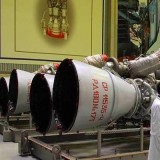Chinese J-10C fighter jet intercepts US RC-135W Rivet Joint strategic reconnaissance aircraft near Taiwan alleging air space violation

{loadposition bannertop}
{loadposition sidebarpub}
As reported by the Liberty Times on April 3, 2025, a U.S. military aircraft was intercepted by a Chinese military aircraft at 06:47 local time on April 3, 2025, while flying over international airspace southwest of Taiwan, near the Hengchun Peninsula. The encounter involved a radio exchange between the two sides, in which the Chinese pilot stated, “U.S. military aircraft, you have entered the China Taiwan 24 nautical mile zone, what is your intention?” The U.S. pilot replied, “I am operating in international airspace in accordance with international law.” The U.S. aircraft continued its mission after the interaction, and no further incidents were reported.Follow Army Recognition on Google News at this link
This interception by a Chinese J-10C fighter jet occurred within the broader context of increased Chinese military operations near Taiwan. In 2024, Taiwan recorded over 1,000 instances of PLA aircraft entering its air defense identification zone (ADIZ). (Picture source: Chinese MoD)
Based on publicly available flight tracking data, Chinese and Taiwanese media coverage, and open-source, the U.S. military aircraft intercepted by a Chinese fighter near Taiwan on April 3, 2025, was most likely an RC-135W Rivet Joint strategic reconnaissance aircraft. Retired PLA Navy colonel Lu Lishi stated on China Television’s “Headline Talk” program that the intercepted aircraft was neither an F-15 nor an F-16, and identified the P-8A Poseidon or the RC-135 as the most probable candidates. Additional flight signal data and radio monitoring revealed that an RC-135W had departed from the Ryukyu Islands, approached to within approximately 100 kilometers north of Taiwan, and was engaged in high-intensity surveillance operations—timed with the second day of the PLA’s “Strait Thunder-2025A” exercise.
The aircraft reportedly operated with its ADS-B transponder turned on throughout the mission, allowing observers to reconstruct its track. Aerial activity logs and radio recordings suggested a prolonged and close-range encounter between the RC-135W and Chinese J-10C fighters, including possible tailing maneuvers and signal jamming. Image and signal analyses indicated the RC-135W’s primary mission was likely to collect electromagnetic emissions and telemetry from PLA long-range rocket launches aimed at simulated targets in the East China Sea. However, Taiwanese sources noted that the aircraft withdrew toward the Ryukyu Islands approximately one hour before the PLA’s live-fire window, suggesting that Chinese interceptors successfully pushed the aircraft out of the designated exercise area.
Lu Lishi stated on China Television’s “Headline Talk” program on the 3rd that the U.S. military aircraft was neither an F-15 nor an F-16, and that the most likely types were a P-8A or an RC-135. The intercept occurred shortly after the conclusion of a two-day People’s Liberation Army (PLA) exercise, designated “Strait Thunder-2025A,” conducted by the PLA’s Eastern Theater Command in the central and southern sectors of the Taiwan Strait. Although the PLA announced the official end of the exercise on the evening of April 2, the Shandong aircraft carrier group remained active in the region. Taiwan’s Ministry of National Defense (MND) reported that this group was operating west of the Bashi Channel, a strategic waterway connecting the South China Sea to the Philippine Sea. According to open-source defense monitoring, U.S. reconnaissance and anti-submarine aircraft frequently conduct operations in the Bashi Channel and South China Sea. These flights are routinely monitored and sometimes challenged by Chinese military aircraft.
In the 24-hour period from April 2 to April 3, Taiwan’s MND reported detecting 59 PLA aircraft of various types, including drones, and 23 PLA Navy vessels, along with eight government-affiliated ships. Of the 59 aircraft, 31 crossed the median line of the Taiwan Strait and entered the northern, central, southeastern, and southwestern sectors of Taiwan’s air defense identification zone (ADIZ). The MND also reported that PLA aircraft operated in coordination with PLA Navy vessels. In response, Taiwan deployed its own aircraft, naval ships, and coastal missile systems to monitor and respond to the activity.
This event occurred within the broader context of increased Chinese military operations near Taiwan. In 2024, Taiwan recorded over 1,000 instances of PLA aircraft entering its ADIZ. These activities include flights that do not necessarily enter Taiwan’s sovereign airspace but are tracked as part of the island’s national security monitoring. Chinese military aircraft have also frequently crossed the median line of the Taiwan Strait, which was previously observed as an informal boundary to avoid military escalation. The PLA’s operational posture includes a combination of fixed-wing aircraft, rotary-wing platforms, and unmanned systems.
The Boeing RC-135W River Joint reconnaissance aircraft reportedly operated with its ADS-B transponder turned on throughout the mission, allowing observers to reconstruct its track. (Picture source: US DoD)
The frequency of PLA military activity around Taiwan is a subject of concern in defense assessments. According to multiple public sources, including aviation monitors and media reports, intercepts and close-range interactions between PLA and foreign military aircraft, including those of the United States, have increased in the airspace surrounding Taiwan. In some of these interactions, Chinese pilots have issued radio warnings claiming jurisdiction over airspace adjacent to Taiwan. One such communication recorded in a separate incident included a Chinese pilot stating, “This is our land, we can do what we want.” Similar rhetoric has been observed in communications between PLA Navy vessels and ships transiting near Taiwan, in which references are made to a 24-nautical mile “zone” around Taiwan. While the contiguous zone concept under international law allows for limited jurisdiction up to 24 nautical miles from a state’s coast, such zones do not confer full airspace control. The U.S. position, reiterated in multiple official statements, is that its military forces will continue to operate wherever international law permits.
Taiwan’s MND has stated that the increase in PLA activities places pressure on its armed forces. According to a report published in Le Monde on April 1, 2025, Taiwan’s air force maintains a constant alert posture to respond to approaching PLA aircraft. The article documented pilot readiness at Hsinchu Air Base, where Taiwanese Mirage 2000 aircraft are prepared for immediate scramble operations. It also described the procedures followed by ground crews to perform rapid aircraft checks and armaments loading under hardened shelters. According to the interview, pilots and personnel have noted an increase in frequency of these missions in recent years, with aircraft either already on patrol being redirected or new flights launched depending on proximity and threat assessment.
The incident on April 3, 2025, is consistent with prior cases involving U.S. military flights near Taiwan that were met with Chinese warnings. In January, another recorded event involved a PLA Navy ship stating that Taiwan’s 24-nautical mile contiguous zone “does not exist,” further asserting that Taiwan is part of China. The Chinese government maintains that it considers Taiwan part of its territory and views foreign military activity in areas adjacent to the island as sensitive. The United States does not recognize China’s sovereignty over Taiwan and continues to maintain unofficial relations with Taipei under the Taiwan Relations Act.
Regional governments and international observers continue to monitor developments in the Taiwan Strait closely. The combination of ongoing PLA exercises, the continued presence of Chinese military forces around Taiwan, and the proximity of foreign military aircraft and vessels creates an operational environment where further incidents cannot be ruled out. Taiwan’s MND has called on China to avoid actions that could lead to miscalculations, while U.S. officials have reaffirmed their commitment to operate in accordance with international law.

{loadposition bannertop}
{loadposition sidebarpub}
As reported by the Liberty Times on April 3, 2025, a U.S. military aircraft was intercepted by a Chinese military aircraft at 06:47 local time on April 3, 2025, while flying over international airspace southwest of Taiwan, near the Hengchun Peninsula. The encounter involved a radio exchange between the two sides, in which the Chinese pilot stated, “U.S. military aircraft, you have entered the China Taiwan 24 nautical mile zone, what is your intention?” The U.S. pilot replied, “I am operating in international airspace in accordance with international law.” The U.S. aircraft continued its mission after the interaction, and no further incidents were reported.
Follow Army Recognition on Google News at this link
This interception by a Chinese J-10C fighter jet occurred within the broader context of increased Chinese military operations near Taiwan. In 2024, Taiwan recorded over 1,000 instances of PLA aircraft entering its air defense identification zone (ADIZ). (Picture source: Chinese MoD)
Based on publicly available flight tracking data, Chinese and Taiwanese media coverage, and open-source, the U.S. military aircraft intercepted by a Chinese fighter near Taiwan on April 3, 2025, was most likely an RC-135W Rivet Joint strategic reconnaissance aircraft. Retired PLA Navy colonel Lu Lishi stated on China Television’s “Headline Talk” program that the intercepted aircraft was neither an F-15 nor an F-16, and identified the P-8A Poseidon or the RC-135 as the most probable candidates. Additional flight signal data and radio monitoring revealed that an RC-135W had departed from the Ryukyu Islands, approached to within approximately 100 kilometers north of Taiwan, and was engaged in high-intensity surveillance operations—timed with the second day of the PLA’s “Strait Thunder-2025A” exercise.
The aircraft reportedly operated with its ADS-B transponder turned on throughout the mission, allowing observers to reconstruct its track. Aerial activity logs and radio recordings suggested a prolonged and close-range encounter between the RC-135W and Chinese J-10C fighters, including possible tailing maneuvers and signal jamming. Image and signal analyses indicated the RC-135W’s primary mission was likely to collect electromagnetic emissions and telemetry from PLA long-range rocket launches aimed at simulated targets in the East China Sea. However, Taiwanese sources noted that the aircraft withdrew toward the Ryukyu Islands approximately one hour before the PLA’s live-fire window, suggesting that Chinese interceptors successfully pushed the aircraft out of the designated exercise area.
Lu Lishi stated on China Television’s “Headline Talk” program on the 3rd that the U.S. military aircraft was neither an F-15 nor an F-16, and that the most likely types were a P-8A or an RC-135. The intercept occurred shortly after the conclusion of a two-day People’s Liberation Army (PLA) exercise, designated “Strait Thunder-2025A,” conducted by the PLA’s Eastern Theater Command in the central and southern sectors of the Taiwan Strait. Although the PLA announced the official end of the exercise on the evening of April 2, the Shandong aircraft carrier group remained active in the region. Taiwan’s Ministry of National Defense (MND) reported that this group was operating west of the Bashi Channel, a strategic waterway connecting the South China Sea to the Philippine Sea. According to open-source defense monitoring, U.S. reconnaissance and anti-submarine aircraft frequently conduct operations in the Bashi Channel and South China Sea. These flights are routinely monitored and sometimes challenged by Chinese military aircraft.
In the 24-hour period from April 2 to April 3, Taiwan’s MND reported detecting 59 PLA aircraft of various types, including drones, and 23 PLA Navy vessels, along with eight government-affiliated ships. Of the 59 aircraft, 31 crossed the median line of the Taiwan Strait and entered the northern, central, southeastern, and southwestern sectors of Taiwan’s air defense identification zone (ADIZ). The MND also reported that PLA aircraft operated in coordination with PLA Navy vessels. In response, Taiwan deployed its own aircraft, naval ships, and coastal missile systems to monitor and respond to the activity.
This event occurred within the broader context of increased Chinese military operations near Taiwan. In 2024, Taiwan recorded over 1,000 instances of PLA aircraft entering its ADIZ. These activities include flights that do not necessarily enter Taiwan’s sovereign airspace but are tracked as part of the island’s national security monitoring. Chinese military aircraft have also frequently crossed the median line of the Taiwan Strait, which was previously observed as an informal boundary to avoid military escalation. The PLA’s operational posture includes a combination of fixed-wing aircraft, rotary-wing platforms, and unmanned systems.

The Boeing RC-135W River Joint reconnaissance aircraft reportedly operated with its ADS-B transponder turned on throughout the mission, allowing observers to reconstruct its track. (Picture source: US DoD)
The frequency of PLA military activity around Taiwan is a subject of concern in defense assessments. According to multiple public sources, including aviation monitors and media reports, intercepts and close-range interactions between PLA and foreign military aircraft, including those of the United States, have increased in the airspace surrounding Taiwan. In some of these interactions, Chinese pilots have issued radio warnings claiming jurisdiction over airspace adjacent to Taiwan. One such communication recorded in a separate incident included a Chinese pilot stating, “This is our land, we can do what we want.” Similar rhetoric has been observed in communications between PLA Navy vessels and ships transiting near Taiwan, in which references are made to a 24-nautical mile “zone” around Taiwan. While the contiguous zone concept under international law allows for limited jurisdiction up to 24 nautical miles from a state’s coast, such zones do not confer full airspace control. The U.S. position, reiterated in multiple official statements, is that its military forces will continue to operate wherever international law permits.
Taiwan’s MND has stated that the increase in PLA activities places pressure on its armed forces. According to a report published in Le Monde on April 1, 2025, Taiwan’s air force maintains a constant alert posture to respond to approaching PLA aircraft. The article documented pilot readiness at Hsinchu Air Base, where Taiwanese Mirage 2000 aircraft are prepared for immediate scramble operations. It also described the procedures followed by ground crews to perform rapid aircraft checks and armaments loading under hardened shelters. According to the interview, pilots and personnel have noted an increase in frequency of these missions in recent years, with aircraft either already on patrol being redirected or new flights launched depending on proximity and threat assessment.
The incident on April 3, 2025, is consistent with prior cases involving U.S. military flights near Taiwan that were met with Chinese warnings. In January, another recorded event involved a PLA Navy ship stating that Taiwan’s 24-nautical mile contiguous zone “does not exist,” further asserting that Taiwan is part of China. The Chinese government maintains that it considers Taiwan part of its territory and views foreign military activity in areas adjacent to the island as sensitive. The United States does not recognize China’s sovereignty over Taiwan and continues to maintain unofficial relations with Taipei under the Taiwan Relations Act.
Regional governments and international observers continue to monitor developments in the Taiwan Strait closely. The combination of ongoing PLA exercises, the continued presence of Chinese military forces around Taiwan, and the proximity of foreign military aircraft and vessels creates an operational environment where further incidents cannot be ruled out. Taiwan’s MND has called on China to avoid actions that could lead to miscalculations, while U.S. officials have reaffirmed their commitment to operate in accordance with international law.





